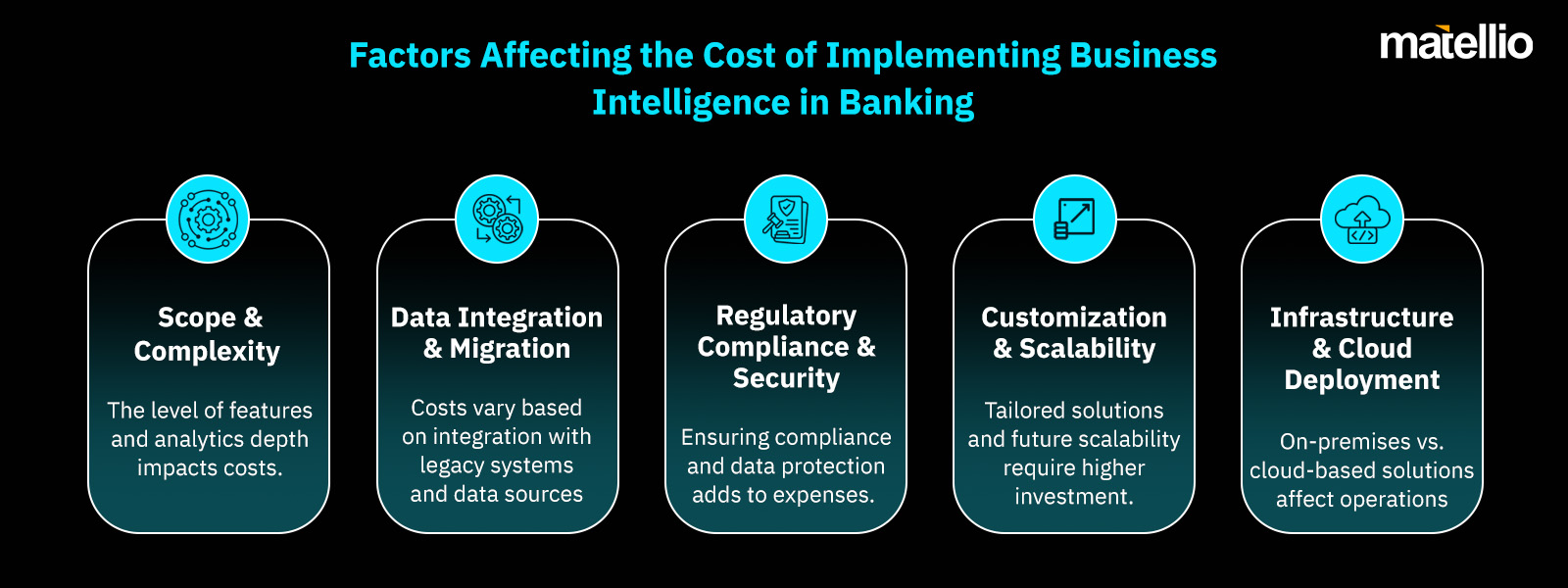
The banking industry is evolving rapidly, driven by digital transformation and the increasing need for data-driven decision-making. Business intelligence in banking plays a crucial role in helping financial institutions analyze vast amounts of structured and unstructured data to enhance operational efficiency, mitigate risks, and improve customer experiences.
With rising competition, stricter regulatory requirements, and the growing adoption of AI-driven financial services, banks must leverage BI tools to stay ahead. From fraud detection and predictive analytics to personalized financial services, BI enables banks to optimize processes, make informed strategic decisions, and deliver more seamless, customer-centric banking experiences.
What is Business Intelligence (BI)?
Business intelligence in banking refers to the process of collecting, analyzing, and visualizing data to support strategic and operational decision-making. By leveraging BI tools, financial institutions can extract valuable insights from vast amounts of structured and unstructured data, enabling them to enhance efficiency, mitigate risks, and improve customer experiences. The adoption of BI in banking is critical for modern financial operations, allowing institutions to stay competitive in a data-driven market, optimize internal processes, and offer more personalized services to customers.
Core Components of BI in Banking
Data Warehousing
A centralized repository that consolidates financial data from multiple sources, including transactional databases, customer records, loan applications, and investment portfolios. It ensures secure storage, quick retrieval, and seamless integration with BI tools to support data-driven decision-making.
Big Data Analytics
AI-driven analysis processes massive datasets in real-time, uncovering trends, patterns, and anomalies. Banks use big data analytics to detect fraudulent transactions, optimize loan approvals, and personalize marketing strategies based on customer behavior. The application of bi in banking industry helps banks utilize predictive analytics to enhance security, compliance, and customer retention.
Predictive Analytics
Advanced machine learning algorithms analyze historical data to forecast future trends, risks, and opportunities. Predictive analytics helps banks assess credit risk, anticipate market fluctuations, and refine investment strategies, leading to more informed financial planning. The integration of business intelligence in banking industry enables financial institutions to make data-backed lending decisions, reducing risk and improving profitability.
Data Visualization & Reporting
Interactive dashboards and dynamic reporting tools translate complex financial data into intuitive visual formats. BI-powered visualization enables decision-makers to track key performance indicators (KPIs), monitor financial health, and generate regulatory compliance reports efficiently. These capabilities showcase the benefits of business intelligence in banking, as banks can enhance transparency, improve customer engagement, and optimize service delivery.
Customer Data Management
BI tools collect and analyze customer data, including transaction history, spending behavior, and financial preferences. By leveraging these insights, banks can deliver hyper-personalized financial products, enhance customer retention, and develop targeted marketing campaigns to drive engagement. This reinforces the importance of business intelligence in banking, as data-driven strategies empower financial institutions to remain competitive and customer-centric.
How Business Intelligence Enhances Banking Operations
Business Intelligence in Banking is transforming the industry by enabling financial institutions to harness vast amounts of data for smarter decision-making. From enhancing customer experiences to optimizing risk management and operational efficiency, BI helps banks gain a competitive edge. Here’s how business intelligence in banking sector is reshaping banking operations:
 Enhanced Customer Experience
Enhanced Customer Experience
Modern banking requires personalized customer interactions. Business intelligence for banking allows financial institutions to analyze transaction histories, financial behaviors, and customer preferences to offer tailored financial products and services. By implementing AI-driven chatbots, personalized loan recommendations, and targeted marketing campaigns, banks can improve customer engagement and satisfaction. BI also helps banks anticipate customer needs, leading to higher retention rates and better service delivery.
 Risk Management & Fraud Prevention
Risk Management & Fraud Prevention
Fraud detection and risk mitigation are critical for financial institutions. Financial business intelligence powers fraud detection systems that analyze transactional patterns in real-time, flagging suspicious activities such as unauthorized transactions or identity theft attempts. Advanced analytics enable banks to take proactive measures, reducing fraud losses and improving security. BI also helps banks assess credit risks more accurately, ensuring that high-risk transactions receive additional scrutiny.
 Optimized Loan & Credit Management
Optimized Loan & Credit Management
Approving loans requires evaluating customer creditworthiness, and BI in banking enhances this process by leveraging predictive analytics. By analyzing spending patterns, credit histories, and repayment behaviors, banks can make data-backed lending decisions that minimize the risk of loan defaults. Automated credit scoring models streamline the approval process, reducing processing time and improving lending accuracy. BI also helps banks identify potential loan defaulters in advance, allowing for preemptive risk management.
 Regulatory Compliance & Reporting
Regulatory Compliance & Reporting
Banks must adhere to strict regulatory requirements and generate detailed compliance reports. Business intelligence in banking industry simplifies compliance by automating report generation and ensuring financial institutions meet industry regulations. By continuously tracking regulatory changes, BI tools help banks maintain transparency, reduce manual errors, and avoid penalties. Automated compliance monitoring also ensures that financial institutions operate within legal boundaries while reducing the administrative burden on compliance teams.
 Cost Reduction & Operational Efficiency
Cost Reduction & Operational Efficiency
Operational efficiency is crucial in banking, and BI in banking industry enables automation across multiple departments. From streamlining customer service operations to optimizing financial reporting, BI helps banks reduce costs and improve resource allocation. Automated workflows eliminate redundant tasks, minimize errors, and enhance overall productivity. Real-time insights into operational performance allow banks to identify inefficiencies and make data-driven improvements.
 Data-Driven Decision-Making
Data-Driven Decision-Making
Banks handle large volumes of data daily, and business intelligence in financial industry converts this data into actionable insights. By monitoring financial trends, customer behaviors, and investment opportunities, BI enables banks to make informed strategic decisions. Whether adjusting interest rates, launching new services, or optimizing financial planning, data-driven decision-making helps banks remain competitive and agile in a fast-changing market.
 Competitive Advantage
Competitive Advantage
In a highly competitive financial landscape, banks that leverage bi for financial services gain a significant advantage. Real-time insights into market trends, customer preferences, and operational performance allow banks to adapt quickly to industry changes. BI-driven institutions can innovate faster, personalize services more effectively, and optimize digital banking experiences. By integrating BI with digital transformation services, banks can future-proof their operations and maintain long-term success.
Harness The Power of Business Intelligence in Banking and Transform Your Financial Operations! Business Intelligence Services are revolutionizing how financial institutions operate, enabling data-driven strategies that enhance efficiency, security, and customer experience. BI applications extend across multiple banking functions, from risk management to customer engagement. Below are key use cases where business intelligence in banking is making a significant impact. Banks serve a diverse range of customers with different financial needs, and business intelligence in banking sector enables institutions to segment their customers effectively. BI systems analyze spending patterns, credit histories, transaction behaviors, and customer preferences to create targeted financial products. With these insights, banks can personalize services such as loan offers, investment recommendations, and promotional campaigns. Personalized banking experiences lead to higher customer satisfaction, improved loyalty, and increased product adoption. Financial fraud is a growing concern, and business intelligence financial services play a critical role in strengthening security measures. By leveraging AI-powered analytics, BI tools monitor transaction patterns in real-time and identify anomalies that may indicate fraudulent activities. Whether detecting unusual withdrawals, unauthorized account access, or money laundering attempts, BI enhances fraud prevention efforts. Banks can set automated alerts for suspicious activities and take immediate action to mitigate risks, reducing financial losses and ensuring regulatory compliance. Granting loans and credit facilities requires precise risk assessment, and business intelligence in financial industry allows banks to evaluate creditworthiness more accurately. BI platforms analyze customer income levels, past loan repayment histories, spending behaviors, and economic indicators to determine potential risks. Predictive analytics helps banks forecast a borrower’s ability to repay, reducing the chances of defaults. With bi in banking, banks can implement dynamic risk models that adapt to market trends, ensuring more reliable lending decisions. Accurate financial reporting is crucial for decision-making, and bi in banking industry facilitates real-time access to key financial data. BI tools collect, process, and present data related to revenue, expenses, operational efficiency, and profitability. This enables banks to track their financial performance on a daily basis and adjust strategies accordingly. Real-time reporting also improves transparency, allowing bank executives to make informed investment decisions while ensuring compliance with industry regulations. Customer retention is a priority for banks, and the importance of business intelligence in banking includes the ability to enhance customer loyalty through data-driven insights. BI platforms analyze transaction histories, engagement patterns, and feedback data to identify at-risk customers and implement proactive retention strategies. Banks can design reward programs, personalized incentives, and targeted communication to strengthen customer relationships. By understanding customer needs better, banks can increase lifetime value and minimize churn rates. Financial institutions must comply with complex regulations, and business intelligence for banking extends to automating compliance management. BI solutions help banks monitor and document regulatory requirements, reducing the risk of non-compliance penalties. Automated reporting tools generate audit-ready reports, ensuring transparency and accuracy in financial statements. By tracking compliance metrics in real time, banks can maintain a strong regulatory standing and adapt to policy changes swiftly. Managing physical banking infrastructure requires strategic decision-making, and bi for financial services offers data-driven solutions. BI tools analyze transaction data, customer footfall, and geographic demand to optimize ATM placements and branch locations. Banks can determine the best areas for new branches, adjust cash replenishment schedules, and improve resource allocation. By optimizing network operations, banks enhance customer convenience while reducing unnecessary operational costs. Many banks still operate on outdated infrastructure, making legacy system migration an essential aspect of BI implementation. Modern BI solutions help financial institutions migrate from traditional, manual processes to cloud-based and AI-driven analytics systems. This transition improves data accessibility, streamlines workflows, and enhances security, ensuring that banks can leverage real-time insights without operational bottlenecks. Want to Upgrade Your Banking Operations with Business Intelligence? While business intelligence in banking enables financial institutions to make data-driven decisions and enhance operational efficiency, its implementation comes with challenges. Banks must address these issues strategically to maximize the benefits of BI while ensuring compliance, security, and operational feasibility. Below are key challenges and their solutions for effective BI integration in the banking sector. Challenge: Banks handle vast amounts of sensitive financial data, including customer transactions, credit card information, and personal details. Protecting this data from cyber threats while ensuring compliance with regulations such as GDPR, PCI DSS, and CCPA remains a critical challenge. Any security breach can lead to financial losses, reputational damage, and regulatory penalties. Solution: Implementing business intelligence in financial industry requires a robust cybersecurity framework. Banks should use advanced encryption methods, multi-factor authentication, and role-based access controls to safeguard financial data. AI-driven fraud detection and real-time monitoring systems help identify suspicious activities, reducing security risks. Additionally, ensuring regular audits and compliance reporting helps maintain regulatory adherence. Challenge: Many banks operate on outdated infrastructure and legacy systems that are not designed for modern business intelligence financial services. Integrating BI solutions with these systems can be complex, leading to inefficiencies and data silos. Legacy systems often lack compatibility with AI-driven analytics and cloud-based tools, limiting the bank’s ability to harness real-time insights. Solution: To overcome bi for financial services integration challenges, financial institutions should gradually transition to cloud-based BI solutions. Cloud platforms offer scalable and flexible data integration, allowing banks to modernize their infrastructure without disrupting daily operations. Implementing APIs and middleware solutions enables seamless data exchange between legacy systems and new BI platforms, ensuring a smooth transition while maintaining operational continuity. Challenge: Deploying enterprise-wide business intelligence for banking requires substantial financial investment. Costs associated with infrastructure upgrades, software licensing, data storage, and hiring skilled personnel can be a barrier to adoption, especially for mid-sized banks. Additionally, unstructured implementation plans can lead to budget overruns and ineffective BI deployment. Solution: Banks should adopt scalable financial business intelligence solutions that allow phased implementation. Instead of deploying a full-fledged BI system at once, institutions can start with core functionalities like dashboards and reporting tools. As banks realize ROI, they can expand BI capabilities, optimizing costs while ensuring maximum impact. Subscription-based and cloud BI solutions also provide cost-effective options, allowing banks to pay for only the services they need. Challenge: Successful bi in banking implementation requires skilled professionals who can interpret complex financial insights and convert them into actionable strategies. However, there is a shortage of qualified data analysts in the financial sector, making it difficult for banks to fully leverage BI capabilities. Without the right expertise, banks risk underutilizing BI solutions or misinterpreting data-driven insights. Solution: To address this issue, banks should invest in Business Intelligence Consultation services and training programs for their existing workforce. Upskilling employees in data analytics, predictive modeling, and BI tool usage ensures better decision-making and maximizes the value of BI solutions. Additionally, partnering with BI experts and consulting firms can help banks bridge the skill gap while ensuring smooth BI implementation. Challenge: For bi in banking industry, data accuracy is critical. Inconsistent, incomplete, or outdated financial data can result in inaccurate reports, leading to poor decision-making. Banks often struggle with fragmented data sources, which makes consolidating and verifying financial information a challenge. Solution: Implementing business intelligence in banking industry requires robust data cleansing and validation tools. Banks should establish data governance frameworks that standardize data collection, storage, and validation processes. Real-time data monitoring systems help identify discrepancies, ensuring that only high-quality data is used for analysis. AI-powered tools can also automate data accuracy checks, reducing manual errors and improving decision-making reliability. Challenge: Banks generate vast amounts of historical data over the years, often stored in multiple formats across different systems. Migrating this data while maintaining integrity, security, and compliance can be a daunting task. Solution: Banks should leverage data migration services to ensure a smooth and secure transition of financial data to modern BI platforms. Implementing ETL (Extract, Transform, Load) processes and cloud-based data warehouses enables efficient migration without disrupting banking operations. Data validation and reconciliation protocols further ensure accuracy and consistency in migrated data. Overcome Banking Challenges with the Power of Business Intelligence! Implementing business intelligence in banking is a transformative process that enables banks to harness data for better decision-making, risk management, and operational efficiency. However, to maximize its potential, financial institutions must follow a structured implementation plan. Below are the key steps for successfully integrating BI in the banking sector. Before launching a BI initiative, banks must outline specific goals. Whether the focus is on fraud detection, customer segmentation, risk assessment, or regulatory compliance, having a well-defined objective ensures that the BI strategy aligns with the bank’s operational needs. A clear roadmap helps prioritize features and functionalities that drive real value. Our experts help financial institutions establish well-defined BI goals, ensuring a structured and efficient business intelligence in banking industry implementation. By conducting an in-depth analysis of current challenges, we create a roadmap that aligns BI strategies with business objectives. Selecting the right BI tools is crucial for long-term success. Banks need solutions that can process large volumes of data, provide real-time insights, and support advanced reporting. The ideal BI tool should offer interactive dashboards, AI-driven analytics, and seamless integration with core banking systems. Our team specializes in business intelligence for banking, helping financial institutions choose the best BI tools that align with their data needs. We assess various BI platforms to ensure they offer scalability, customization, and high-performance analytics. For BI to deliver meaningful insights, it must integrate seamlessly with existing banking systems such as CRM, ERP, and financial databases. Without proper integration, banks may face data silos, leading to inefficiencies and inaccuracies in reporting. Cloud-based solutions ensure scalability and real-time data access. Our expertise in cloud integration services enables banks to connect their BI tools with existing banking infrastructure. We ensure smooth data flow across multiple platforms, allowing real-time analytics, enhanced security, and seamless scalability. Modern BI goes beyond traditional reporting by incorporating AI and machine learning for predictive analytics. AI-driven models can detect fraud patterns, assess credit risks, and analyze customer behavior, enabling banks to make proactive decisions. We assist financial institutions in integrating AI in Banking solutions within their BI platforms. Our AI-powered analytics enhance decision-making, automate fraud detection, and provide data-driven insights to optimize financial strategies. Security and compliance are top concerns in banking, as financial institutions handle highly sensitive customer data. Implementing robust security frameworks and adhering to global financial regulations such as GDPR, PCI DSS, and CCPA ensures data integrity and customer trust. Our financial business intelligence solutions incorporate encryption, multi-layer authentication, and advanced fraud detection mechanisms. We help banks navigate regulatory challenges, ensuring compliance while securing sensitive financial data. BI solutions are only as effective as the people using them. Without proper training, employees may struggle to leverage the full potential of BI tools. Developing a data-driven culture encourages teams to rely on analytics for strategic decision-making. Our business intelligence financial services include customized training programs for banking professionals. We offer hands-on workshops, continuous support, and role-based training to ensure that employees can utilize BI tools efficiently, enhancing banking operations. The future of business intelligence in banking is being shaped by AI, automation, and predictive analytics. As financial institutions embrace digital transformation, the role of BI is becoming increasingly crucial in driving efficiency, optimizing decision-making, and enhancing customer experiences. Below are key trends that will define the next phase of BI adoption in the financial sector. Artificial intelligence is revolutionizing financial business intelligence by enabling real-time data analysis, automated financial forecasting, and fraud detection. AI-driven models improve risk assessment, detect anomalies, and provide data-driven insights, allowing banks to enhance operational efficiency and security. Banks are increasingly shifting towards cloud-hosted business intelligence financial services to ensure scalability, cost efficiency, and secure access to real-time data. Cloud-based BI platforms allow financial institutions to centralize data, eliminate infrastructure constraints, and provide secure analytics capabilities from anywhere. AI-driven BI enables hyper-personalization, where banks tailor financial products, credit offers, and investment strategies based on individual customer behavior. By leveraging business intelligence for banking, financial institutions can deliver targeted services, optimize marketing efforts, and improve customer engagement through personalized recommendations. With the increasing complexity of financial risk management, banks are adopting bi for financial services to enhance predictive analytics. Machine learning algorithms within BI tools help assess creditworthiness, forecast loan default probabilities, and analyze economic trends, empowering banks with data-driven risk mitigation strategies. As regulatory requirements become more stringent, business intelligence in banking industry is playing a critical role in automating compliance reporting. BI-powered automation tools streamline audit processes, generate regulatory reports, and ensure financial institutions adhere to global compliance standards, reducing manual errors and operational risks. Banks are leveraging bi in banking to refine their investment strategies, optimizing portfolios based on real-time financial insights. Advanced analytics provide deep insights into asset performance, risk diversification, and market fluctuations, allowing financial institutions to make informed investment decisions and maximize returns. Fraud detection is becoming more sophisticated with the use of AI integration services in BI platforms. AI-powered BI systems analyze transactional data, detect suspicious activity in real-time, and flag potential fraudulent behavior, helping banks reduce financial crime risks and enhance security protocols. Implementing business intelligence in banking is crucial for financial institutions aiming to drive operational efficiency, enhance decision-making, and improve customer engagement. By leveraging BI-driven insights, banks can optimize risk management, strengthen compliance, and deliver personalized financial services, all while staying ahead in an evolving financial landscape. Unlock the full potential of business intelligence in banking sector with tailored solutions designed to improve operational efficiency, strengthen compliance, and enhance customer satisfaction. Fill out the form today and connect with our experts to explore how BI can transform your banking operations. We ensure seamless BI integration with your banking infrastructure, including CRM, ERP, and data management systems. Our approach maintains data consistency and enhances accessibility across platforms. Costs vary based on project complexity, data volume, and customization needs. We provide transparent pricing and scalable solutions to fit your business objectives. We provide ongoing support, including performance monitoring, system updates, and troubleshooting. Our team ensures that your BI platform remains optimized and secure. Our BI solutions automate compliance reporting and integrate fraud detection mechanisms that monitor transactions in real time, reducing regulatory risks and financial crimes. Absolutely! We tailor business intelligence in banking solutions to fit specific banking functions, from customer analytics and financial forecasting to risk assessment and compliance tracking. Business Intelligence Use Cases in Banking
Customer Segmentation & Personalization
Fraud Detection & Prevention
Credit Risk Assessment
Real-Time Financial Reporting
Customer Retention & Loyalty Programs
Regulatory Compliance & Audit Reporting
Optimized ATM & Branch Network Management
Modernizing Legacy Systems with BI
Challenges of Implementing Business Intelligence in Banking
Data Security & Privacy Compliance
Legacy System Integration
High Implementation Costs
Lack of Skilled Data Analysts
Data Quality & Accuracy Issues
Migration of Historical Data
Steps to Successfully Implement Business Intelligence in Banking
 Define Clear BI Objectives
Define Clear BI Objectives  Choose the Right BI Tools
Choose the Right BI Tools  Invest in Data Integration & Cloud Solutions
Invest in Data Integration & Cloud Solutions  Implement AI & Machine Learning for Deeper Insights
Implement AI & Machine Learning for Deeper Insights  Ensure Compliance & Data Security
Ensure Compliance & Data Security  Train Employees & Foster a Data-Driven Culture
Train Employees & Foster a Data-Driven Culture 
Future Trends in Business Intelligence for Banking
AI-Powered Financial Analytics
Cloud-Based BI Solutions
Hyper-Personalized Banking
Predictive Analytics for Risk Management
Automated Regulatory Compliance
Data-Driven Investment Strategies
AI-Driven Fraud Prevention
How Can We Guide You with Business Intelligence in Banking?
Our team is here to support you throughout this transformation!
Business Intelligence in Banking FAQ’s
Q1. How can BI be integrated with existing banking systems?
Q2. What are the costs associated with implementing BI in banking?
Q3. What kind of support do you offer for BI in banking?
Q4. How does BI help banks with compliance and fraud detection?
Q5. Can BI solutions be customized for different banking operations?
 Enhanced Customer Experience
Enhanced Customer Experience Risk Management & Fraud Prevention
Risk Management & Fraud Prevention Optimized Loan & Credit Management
Optimized Loan & Credit Management Regulatory Compliance & Reporting
Regulatory Compliance & Reporting Cost Reduction & Operational Efficiency
Cost Reduction & Operational Efficiency Data-Driven Decision-Making
Data-Driven Decision-Making Competitive Advantage
Competitive Advantage

